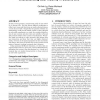Free Online Productivity Tools
i2Speak
i2Symbol
i2OCR
iTex2Img
iWeb2Print
iWeb2Shot
i2Type
iPdf2Split
iPdf2Merge
i2Bopomofo
i2Arabic
i2Style
i2Image
i2PDF
iLatex2Rtf
Sci2ools
121
click to vote
CORR
2008
Springer
2008
Springer
Characterizing User Mobility in Second Life
In this work we present a measurement study of user mobility in Second Life. We first discuss different techniques to collect user traces and then focus on results obtained using a crawler that we built. Tempted by the question whether our methodology could provide similar results to those obtained in real-world experiments, we study the statistical distribution of user contacts and show that user mobility in Second Life presents similar traits to those of real humans. We further push our analysis to radio networks that emerge from user interaction and show that they are highly clustered. Lastly, we focus on the spatial properties of user movements and observe that users in Second Life revolve around several points of interest traveling in general short distances. Using maximum likelihood estimation, we show that our empirical data best fit to power-law with cutoff distributions, indicating that contact time distributions in a virtual environment has very similar characteristics to th...
CORR 2008 | Education | Second Life | User | User Mobility |
Related Content
| Added | 09 Dec 2010 |
| Updated | 09 Dec 2010 |
| Type | Journal |
| Year | 2008 |
| Where | CORR |
| Authors | Chi-Anh La, Pietro Michiardi |
Comments (0)

